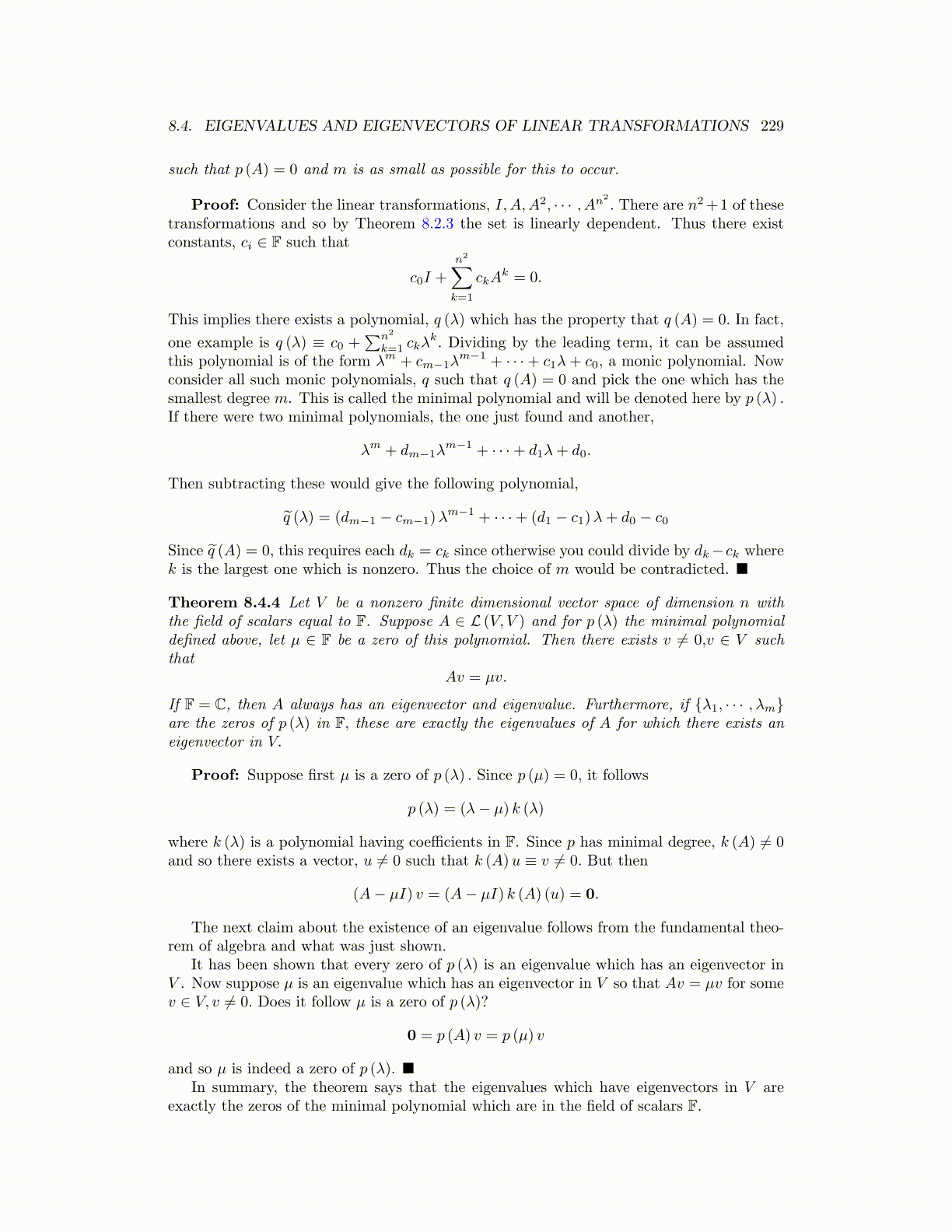
8.4. EIGENVALUES AND EIGENVECTORS OF LINEAR TRANSFORMATIONS 229
such that p (A) = 0 and m is as small as possible for this to occur.
Proof: Consider the linear transformations, I, A,A2, · · · , An2
. There are n2+1 of thesetransformations and so by Theorem 8.2.3 the set is linearly dependent. Thus there existconstants, ci ∈ F such that
c0I +
n2∑k=1
ckAk = 0.
This implies there exists a polynomial, q (λ) which has the property that q (A) = 0. In fact,
one example is q (λ) ≡ c0 +∑n2
k=1 ckλk. Dividing by the leading term, it can be assumed
this polynomial is of the form λm + cm−1λm−1 + · · ·+ c1λ+ c0, a monic polynomial. Now
consider all such monic polynomials, q such that q (A) = 0 and pick the one which has thesmallest degree m. This is called the minimal polynomial and will be denoted here by p (λ) .If there were two minimal polynomials, the one just found and another,
λm + dm−1λm−1 + · · ·+ d1λ+ d0.
Then subtracting these would give the following polynomial,
q̃ (λ) = (dm−1 − cm−1)λm−1 + · · ·+ (d1 − c1)λ+ d0 − c0
Since q̃ (A) = 0, this requires each dk = ck since otherwise you could divide by dk−ck wherek is the largest one which is nonzero. Thus the choice of m would be contradicted. ■
Theorem 8.4.4 Let V be a nonzero finite dimensional vector space of dimension n withthe field of scalars equal to F. Suppose A ∈ L (V, V ) and for p (λ) the minimal polynomialdefined above, let µ ∈ F be a zero of this polynomial. Then there exists v ̸= 0,v ∈ V suchthat
Av = µv.
If F = C, then A always has an eigenvector and eigenvalue. Furthermore, if {λ1, · · · , λm}are the zeros of p (λ) in F, these are exactly the eigenvalues of A for which there exists aneigenvector in V.
Proof: Suppose first µ is a zero of p (λ) . Since p (µ) = 0, it follows
p (λ) = (λ− µ) k (λ)
where k (λ) is a polynomial having coefficients in F. Since p has minimal degree, k (A) ̸= 0and so there exists a vector, u ̸= 0 such that k (A)u ≡ v ̸= 0. But then
(A− µI) v = (A− µI) k (A) (u) = 0.
The next claim about the existence of an eigenvalue follows from the fundamental theo-rem of algebra and what was just shown.
It has been shown that every zero of p (λ) is an eigenvalue which has an eigenvector inV . Now suppose µ is an eigenvalue which has an eigenvector in V so that Av = µv for somev ∈ V, v ̸= 0. Does it follow µ is a zero of p (λ)?
0 = p (A) v = p (µ) v
and so µ is indeed a zero of p (λ). ■In summary, the theorem says that the eigenvalues which have eigenvectors in V are
exactly the zeros of the minimal polynomial which are in the field of scalars F.